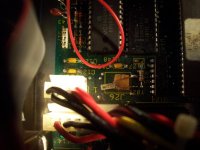Chuck(G)
25k Member
J26B is labeled "+power good". You should have nothing connected to it--it will be pulled high when the unit is powered on. The other side of J26B is GND.
Your reset button should go to J22, pins 1 and 2.
If there's nothing connected to the keylock header, that's okay.
I don't recall whose BIOS you have onboard, but you can check the beep codes here for the more common (e.g. AMI, Phoenix, Award) BIOSes.
Check that your DRAM chips are firmly seated (I recall having a hateful relationship with the sockets on this board). Similarly, check to see that all of your jumpers haven't changed since the board was last in the system (sometimes they can get knocked off).
When repairing things lately, I've gotten into the habit of photographing everything before I disassemble anything. It saves me from relying on my faulty memory or trying to decipher my notes.
Your reset button should go to J22, pins 1 and 2.
If there's nothing connected to the keylock header, that's okay.
I don't recall whose BIOS you have onboard, but you can check the beep codes here for the more common (e.g. AMI, Phoenix, Award) BIOSes.
Check that your DRAM chips are firmly seated (I recall having a hateful relationship with the sockets on this board). Similarly, check to see that all of your jumpers haven't changed since the board was last in the system (sometimes they can get knocked off).
When repairing things lately, I've gotten into the habit of photographing everything before I disassemble anything. It saves me from relying on my faulty memory or trying to decipher my notes.

